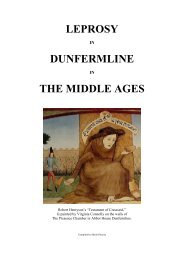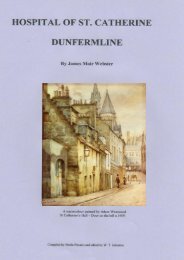PASSAGIUM REGINAE The - Royal Dunfermline
PASSAGIUM REGINAE The - Royal Dunfermline
PASSAGIUM REGINAE The - Royal Dunfermline
You also want an ePaper? Increase the reach of your titles
YUMPU automatically turns print PDFs into web optimized ePapers that Google loves.
family, several of whom came over to Scotland and settled in Fifeshire about<br />
the time of the Irish Rebellion, circa 1689. She died in 1820. Anderson had<br />
two daughters, Helen and Betty, and since his wife‟s name was Helen also,<br />
and the two Helens would probably be called Nelly, it looks as if he<br />
christened his brig after his three nearest female relations. <strong>The</strong> younger<br />
Helen, who died in 1874, was married to John Reid, shipmaster of Limekilns,<br />
father of the John Reid already referred to, and great-grandfather of Lord<br />
Wavertree. <strong>The</strong> old water-colour is particularly interesting on account of the<br />
„two exact views‟ in the one picture of this typical merchant brig of the latter<br />
part of the eighteenth century. We can see her stern so well in the side<br />
drawing, and can read her name there in large black Georgian letters.<br />
It would be a difficult matter now to get the names of all those captains who<br />
sailed vessels from Limekilns from the beginning of last century, and the<br />
following is but an imperfect list of those who resided there and were<br />
connected in one way and another, as shipmasters and shipowners, with the<br />
Fifeshire trade of the nineteenth century: <strong>The</strong> Lawsons; the Baynes; the<br />
Clarks; Mr. Harley; the Wilsons of Academy Square, or Close; Mr.<br />
Stenhouse, father of the present sea-captain who, though he has lived in<br />
retirement there for a considerable time, never sailed from Limekilns; the<br />
Fotheringhams; the Monros (two families); Messrs. Gifford, Reid, Potter (two<br />
families), Young, Liddell, Poole, Whitehead, M‟Laren, and Bryce. When<br />
many of these gave up going to sea or owning vessels, their sons proved<br />
themselves splendid sailors, and got the command of ships sailing over the<br />
whole world, and some of those ships amongst the most seaworthy and fastest<br />
afloat.<br />
Captain Stenhouse, now in his eightieth year, lives in a curious little grey<br />
house wedged in between larger ones in Red Row. He possesses a map of<br />
great interest showing the three journeys he had made round the Horn. In one<br />
of these it took the barque nine weeks to double the point, a matter of 500<br />
miles only, but she kept drifting back owing to headwinds and too little<br />
ballast. On this voyage she was at one moment actually 240 miles south of<br />
the Horn – in Antarctic regions. <strong>The</strong> period covered by the struggle was 25th<br />
September to 26th November 1889, which is of course spring in those<br />
latitudes. A year later Captain Stenhouse sailed round the Horn in eleven<br />
days – a very different story.<br />
A close examination of the two harbours of Limekilns and Brucehaven<br />
should at once show that the former is the older of the two. To begin with, it<br />
is a very natural one, with protection against the winds from the west and<br />
north, whereas Brucehaven is more exposed. It is true that the entrance in the<br />
reef of rock bounding the ancient harbour on its south side is very narrow –<br />
the rock, in very old times, was cut through and the passage is known as the<br />
„ghauts‟ – sometimes wrongly spelt „gatts‟ – but when once a vessel was<br />
26




